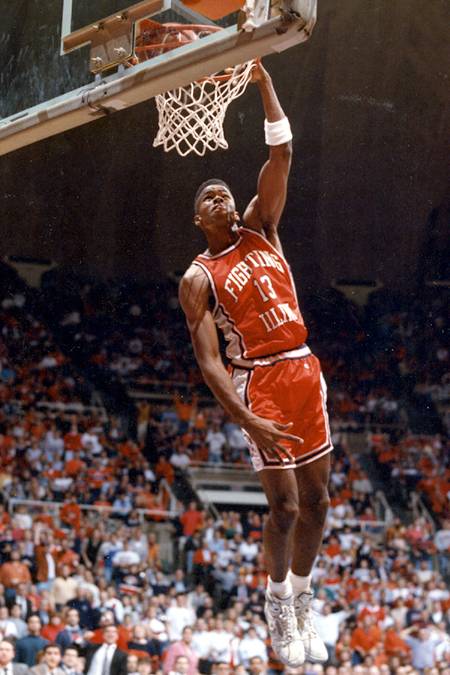 ‘Round these parts, the months of January and February would be completely intolerable if not for Big Ten Conference basketball. It has long been near-weeknightly ritual for hoops-minded Midwesterners to prepare a nice fire, settle down with a delicious snack, and watch the league race unfold. We follow along dutifully, now aided by our very own television network, which lets us see every damned notch on the conference slate. The whole thing builds steadily to those few frenzied March weekends, when all hell breaks loose on CBS…
‘Round these parts, the months of January and February would be completely intolerable if not for Big Ten Conference basketball. It has long been near-weeknightly ritual for hoops-minded Midwesterners to prepare a nice fire, settle down with a delicious snack, and watch the league race unfold. We follow along dutifully, now aided by our very own television network, which lets us see every damned notch on the conference slate. The whole thing builds steadily to those few frenzied March weekends, when all hell breaks loose on CBS…
But we’re not there yet. Right now, well into the third week of league play, the 2010 standings are still virgin, the won/lost records still misleading. We do, however, recognize good players when we see them. And we like to debate their relative worth, just as conference coaches and media do when they select All-Big Ten teams at the conclusion of each season. In keeping with the recent practice of forming “best-of” lists, a few of us at Smile Politely have decided to compile our own All-Conference squads, albeit with a slight twist — we’re choosing players from the past 25 seasons. Why 25, you ask? Well, we’re all around the same age, and our collective basketball consciousness developed about that long ago.
The best Big Ten players of the past quarter-century have mostly been shooting guards and small forwards, all about the same size and with similar talents. So instead of picking the very best players and winding up with five four groups of elite twos and threes, we’ve tried to form actual teams, as if we are basketball coaches. We’ve each selected ten players — five starters and a bench, all the while paying attention to positions and skill sets. Everyone active during the 1985-86 season was eligible, and all current players were fair game as well — altogether, 25 seasons of Big Ten athletes from which to choose.
As you’ll see, our hometown university isn’t very well represented — despite the number of good teams it has produced during the era in question. And, perhaps not at all surprising to knowledgeable fans, the overall level of talent in the league ain’t quite what it used to be…
Please feel free to pick your own team in the comments. We created a spreadsheet of composite stats here that features all the notable players of the last 25 years to help aid your memory.— MATT CAMPBELL
<><><><><><><><><><><><><><><><><><><><><><><><><><><><><><><><><><><>
Matt Campbell — C-U native, local musician, Illini fan
Starters:
G Gary Grant (6-3/185), Michigan (1984-1988)
G Jim Jackson (6-6/210), Ohio State (1989-1992)
G/F Steve Smith (6-7/200), Michigan State (1987-91)
F Glenn Robinson (6-7/225), Purdue (1992-1994)
F/C Chris Webber (6-9/245), Michigan (1991-1993)
Reserves:
G Mateen Cleaves (6-1/200), Michigan State (1996-2000)
G/F Calbert Cheaney (6-7/209), Indiana (1989-1993)
F Glen Rice (6-7/215), Michigan (1985-1989)
F/C Steve Scheffler (6-9/250), Purdue (1986-1990)
C Roy Tarpley (6-11/230), Michigan (1982-1986)
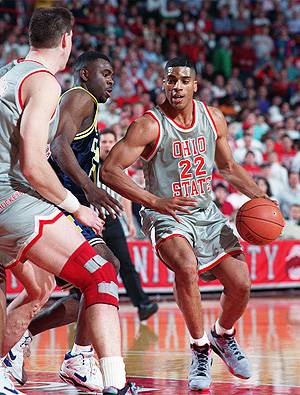 Grant wasn’t dubbed “The General” for the hell of it; he is the Big Ten’s eighth all-time leading scorer, ranks second in steals, and places third in assists. Because of his defensive prowess and shooting ability (46% from behind the arc), he gets the nod at the point here over Cleaves. Jackson famously logged time with 13 NBA teams and Toni Braxton in 14 years after leaving Columbus in 1992, but not before he established himself as a splendid college guard, twice being named Big Ten Player of the Year and All-America. At 6-7, Smith was as good and versatile a swingman as anybody could want, but those who wanted more looked no further than Robinson — easily the best player in the conference since Magic Johnson. Because of this team’s firepower on the wings, here Big Dog will mostly play inside; he’ll dominate like he did at small forward (30 & 10 in 1994), all the while creating trouble for slower fours trying to check him when he does decide to venture out to the perimeter. And if tapping
Grant wasn’t dubbed “The General” for the hell of it; he is the Big Ten’s eighth all-time leading scorer, ranks second in steals, and places third in assists. Because of his defensive prowess and shooting ability (46% from behind the arc), he gets the nod at the point here over Cleaves. Jackson famously logged time with 13 NBA teams and Toni Braxton in 14 years after leaving Columbus in 1992, but not before he established himself as a splendid college guard, twice being named Big Ten Player of the Year and All-America. At 6-7, Smith was as good and versatile a swingman as anybody could want, but those who wanted more looked no further than Robinson — easily the best player in the conference since Magic Johnson. Because of this team’s firepower on the wings, here Big Dog will mostly play inside; he’ll dominate like he did at small forward (30 & 10 in 1994), all the while creating trouble for slower fours trying to check him when he does decide to venture out to the perimeter. And if tapping 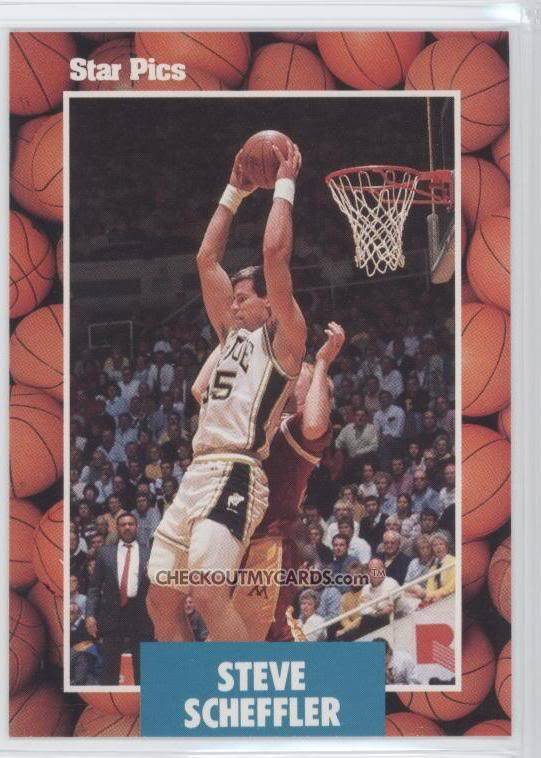 Webber at the five seems a bit peculiar, so be it; the fabbest of the Fabs notched 10 rebounds and 2.5 blocks per game during his two seasons at Michigan.
Webber at the five seems a bit peculiar, so be it; the fabbest of the Fabs notched 10 rebounds and 2.5 blocks per game during his two seasons at Michigan.
The common thread here? Versatility. My favorite team as a youth, the 1988-89 Flyin’ Illini, deployed five near-interchangeable, multi-dimensional players. Somewhat similarly, this All-Big Ten lineup features mid-sized athletes each possessing a multitude of skills, each able to play multiple positions. The bench is also stocked with talent: there’s floor leadership and distribution from Cleaves, more versatility and scoring from Cheaney, outside shooting from Rice, and inside play from Tarpley, who, before his battles with blow, was the best true center of his era in the conference. And, hell, there’s also a white guy at the end of the pine — Mr. Universe wannabe Scheffler, the worst Big Ten Player of the Year (1990) in our lifetime.
<><><><><><><><><><><><><><><><><><><><><><><><><><><><><><><><><><><>
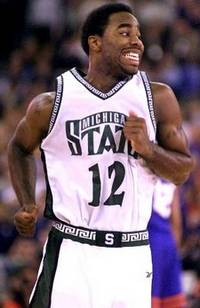
Doug Hoepker: Central Illinois native, copy editor, Illini fan
Starting Five:
PG Mateen Cleaves (6-1/200), Michigan State (1996-2000)
SG Jim Jackson (6-6/210), Ohio State (1989-1992)
SF Glen Rice (6-7/215), Michigan (1985-1989)
PF Chris Webber (6-9/245), Michigan (1991-1993)
C Acie Earl (6-10, 240), Iowa (1990-1994)
Bench:
G Scott Skiles (6-1, 180), Michigan State (1982-1986)
G Steve Smith (6-7, 200), Michigan State (1987-1991)
F Lucas Johnson, Illinois (6-8, 230)
F Reggie Evans (6-8, 245), Iowa (2000-2002)
C Rashard Griffith (7-0, 270), Wisconsin (1993-1995)
Cleaves gives me a distribution-minded point guard (7 APG three seasons in a row) whose weaknesses (shooting) are made up for by above-average defense, quickness, ballhandling, and leadership. The three-time All American will make sure his teammates are filling up the stat sheet while he attends to the rap sheet. To give my offense an above-the-rim aspect, I’m taking former Buckeye standout Jimmy Jackson (22.4 PPG and 5.6 trips to the line his junior year), a much better B10 player than B10 analyst. Jackson’s three-point shooting improved to 40% for his junior season, but he’s not going to light it up from outside, so I’ll have to get some perimeter shooting from my small forward. We all know that Glenn Robinson is the best college talent the Big 10 has produced in the past 25 years (which makes it all the more weird that he played for Purdue). I like the challenge of building a team without him (which also might be weird). So my pick at the 3 is another Glen and my second starter from Flint, Mr. Rice. This gives me an outside shooter (52% on threes his senior season) and a second great scorer (25.6 PPG his senior year on 58% shooting from the floor). For my bigs, I’ll start at power forward with an obvious choice and go with Chris Webber, who could pretty much do it all (except hit free throws). Scoring won’t be a problem for this team, so for my center I’m going with a guy who can defend the rim — Acie Earl. He led the B10 in coolest hair and blocks all four years of his career (including an astounding 4 BPG his junior year), and he could score a little too (nearly 20 PPG as a junior).
Moving to my bench, every team needs a shooter and for my money there have been few better in the B10 than Steve Alford. But I need someone who can sub for Cleaves and distribute the ball, so for my back-up point guard/token white guy I’m choosing Scott Skiles, who was an adequate outsider shooter, a superb guard (27.4 PPG and 6.5 APG as a senior), a B10 Player of 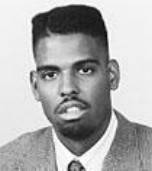 the Year, and a fucking prick with a drug habit. I need size at my other reserve guard, so fellow Spartan Steve Smith is my choice. That gives me a pair of shooters on my bench. To give my team a couple bruisers, I’m going to shock my peers by choosing Reggie Evans, who was actually a decent scorer in college and a hell of a rebounder (11.5 RPG for his career). That’s two players from Iowa (but none from Indiana!). Then I’ll take wild-eyed Lucas Johnson as the lone representative from my hometown Orange & Blue. After all, every bench needs a role player with a maniacal streak. And for my token huge black man, Chicago King’s Rashard Griffith is my pick. During his sophomore season, the bulky seven-footer averaged a double-double for the Badgers (17.2 PPG, 10.8 RPG) and blocked two shots per game before heading to the Euroleagues for a payday.
the Year, and a fucking prick with a drug habit. I need size at my other reserve guard, so fellow Spartan Steve Smith is my choice. That gives me a pair of shooters on my bench. To give my team a couple bruisers, I’m going to shock my peers by choosing Reggie Evans, who was actually a decent scorer in college and a hell of a rebounder (11.5 RPG for his career). That’s two players from Iowa (but none from Indiana!). Then I’ll take wild-eyed Lucas Johnson as the lone representative from my hometown Orange & Blue. After all, every bench needs a role player with a maniacal streak. And for my token huge black man, Chicago King’s Rashard Griffith is my pick. During his sophomore season, the bulky seven-footer averaged a double-double for the Badgers (17.2 PPG, 10.8 RPG) and blocked two shots per game before heading to the Euroleagues for a payday.
My team is short on players from this past decade, so call me nostalgic for my youth.
<><><><><><><><><><><><><><><><><><><><><><><><><><><><><><><><><><><>
Joel Gillespie: Iowa native, Engineer/SP Editor, Hawkeye fan
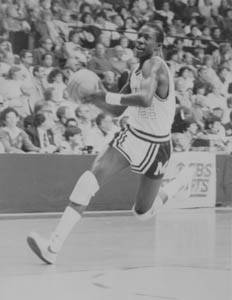
Starting Five:
PG: Gary Grant, Michigan (1984-1988)
SG: Steve Alford, Indiana (1983-1987)
SF: Glenn Robinson, Purdue (1992-1994)
PF: Chris Webber, Michigan (1991-1993)
C: Greg Oden, Ohio State (2006-2007)
Bench:
G: Calbert Cheaney, Indiana (1989-1993)
G: Shawn Respert, Michigan St. (1991-1995)
F: Michael Finley, Wisconsin (1991-1995)
F: D.J. White, Indiana (2004-2008)
C: Les Jepsen, Iowa (1986-1990)
One of the most glaring things about assembling a Big Ten team over the last 25 years is the dearth of quality big men that the conference has produced. There are tons of worthy shooting guards and small forwards to choose from, but among centers and power forwards, the pickings are pretty slim.
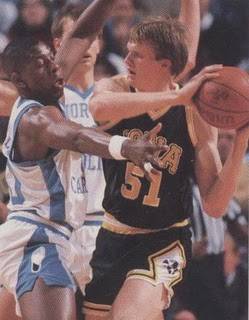 We all know that Oden will be hurt or in foul trouble most of the time for this team, so a quality backup is key. I’ll use D.J. White in that role, and leave Jepsen (who has a legitimate claim to second-most accomplished basketball player to hail from North Dakota, after Phil Jackson and edging Jeff Boschee) on the end of the bench to wave towels and keep the walk-ons company. Webber can slide over to the five if necessary.
We all know that Oden will be hurt or in foul trouble most of the time for this team, so a quality backup is key. I’ll use D.J. White in that role, and leave Jepsen (who has a legitimate claim to second-most accomplished basketball player to hail from North Dakota, after Phil Jackson and edging Jeff Boschee) on the end of the bench to wave towels and keep the walk-ons company. Webber can slide over to the five if necessary.
The backcourt will do most of the heavy lifting for this squad, and they’re well-equipped to handle that. I fear that Gary Grant will get lost in the shuffle in this discussion, and that’s a bummer, because he once averaged more than 20 ppg for a team that also featured Glen Rice; no mean feat. He’s also the top perimeter defender available. Big Dogs’s a shoo-in at small forward, and Alford will take open jumpers all day. The bench guys are pretty interchangeable — if you need someone to fill it up in a hurry, 15 guys can get it done, and I picked three who I remember fondly.
<><><><><><><><><><><><><><><><><><><><><><><><><><><><><><><><><><><>
Seth Fein: C-U native, SP co-founder, Boilermaker fan
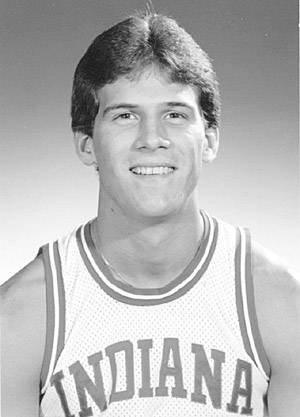 Starting Five:
Starting Five:
C – Greg Oden; Ohio State (2006-2007)
PF – Glenn Robinson; Purdue (1992-1994)
SF – Jalen Rose; Michigan (1991-1994)
SG – Steve Alford; Indiana (1983-1987)
PG – Mateen Cleaves; Michigan State (1996-2000)
Reserves:
C/PF – Chris Webber; Michigan (1991-1993)
SF – Derron Deron Williams; Illinois (2002-2005)
SG – Morris Peterson; Michigan State (1995-2000)
SG – Rumeal Robinson; Michigan (1987-1990)
SG – Jess Settles; Iowa (1993-1999)
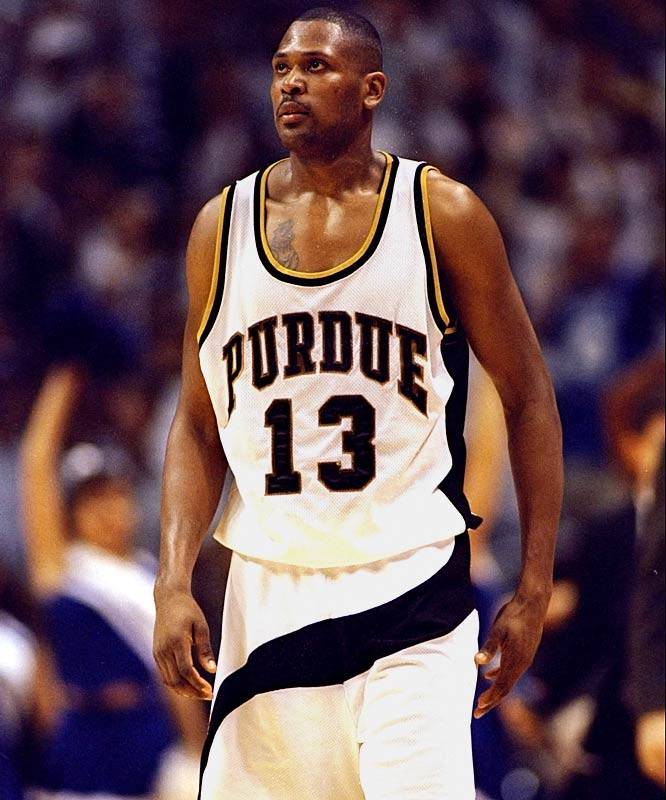 I was just nine years old when Purdue dropped their Sweet 16 game to Kansas State during the 1987-88 campaign that featured “The Three Amigos”: Todd Mitchell, Troy Lewis, and Everette Stephens. Up by nine at half, with arguably the best team in the country on the court, against a team that Purdue had whooped by 20-some odd points to open the season. Final? 73-70 in favor of Mitch Richmond and a Lon Kruger-led Wildcats team that would go on to lose to Kansas and Danny Manning en route to an unlikely National Championship.
I was just nine years old when Purdue dropped their Sweet 16 game to Kansas State during the 1987-88 campaign that featured “The Three Amigos”: Todd Mitchell, Troy Lewis, and Everette Stephens. Up by nine at half, with arguably the best team in the country on the court, against a team that Purdue had whooped by 20-some odd points to open the season. Final? 73-70 in favor of Mitch Richmond and a Lon Kruger-led Wildcats team that would go on to lose to Kansas and Danny Manning en route to an unlikely National Championship.
By the time that 1992 had rolled around, Gene Keady needed a spark. The Final Four berth that Joe “barely cares” Barry Carroll led the Boilers to in 1980 was a distant memory and the fanbase was beginning to question whether or not Keady could recruit in ways that would match people like Bobby Knight or Steve Fisher.
The fact that he couldn’t lead Purdue to a Final Four is the one blemish on an otherwise impeccable two years in the college game. Simply spoken, Glenn Robinson was the best single college basketball player of the modern era.
From Wikipedia: he led “the nation in scoring and became the conference’s all-time single season points leader with 1,030 points. Robinson was unanimously selected as the Big Ten Conference Player of the Year. He also unanimously received the John R. Wooden Award and Naismith Award, the first national player of the year-honored Boilermaker since John Wooden himself did it in 1932 (who also wore the jersey #13). Robinson also was the recipient for the USBWA College Player of the Year. Glenn left Purdue after becoming the only Boilermaker to have more than 1,000 points, 500 rebounds, 100 steals, 100 assists and 50 blocked shots in a career during his two seasons at Purdue, along with a school weightlifting record with a 309-pound clean-and-jerk. His 1,030 points during his senior year made him only the 15th player in college history to score 1,000 points in a season.”
Glenn Robinson was a force.
No player in a major conference since Robinson has averaged the likes of 30 / 11 / 5.
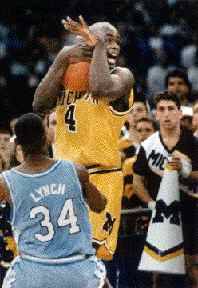 As for the rest of my lineup, the fact that I have Chris Webber as a reserve speaks volumes about the heights to which the Big Ten climbed during the past 25 years. While there is certainly no question as to whether or not the Big Ten is the dominant conference in college basketball (they aren’t), it should never be a situation where it’s written off; now and forever, there will be teams each year that make runs at the Final Four, and that makes it a great thing to be a fan of the conference.
As for the rest of my lineup, the fact that I have Chris Webber as a reserve speaks volumes about the heights to which the Big Ten climbed during the past 25 years. While there is certainly no question as to whether or not the Big Ten is the dominant conference in college basketball (they aren’t), it should never be a situation where it’s written off; now and forever, there will be teams each year that make runs at the Final Four, and that makes it a great thing to be a fan of the conference.
For the most part, I went with players who I felt played well under pressure, even if they didn’t end up winning it all. For me, Derron Deron Williams performance against Arizona in 2005 is a legendary display of both poise and talent. Rumeal Robinson on the line against Seton Hall is in the same category. Mateen Cleaves led his team with more tenacity than perhaps any other point in recent history. To me, it’s how you play under pressure that wins you accolades. And these players, outside of the Big Dog, did just that. Glenn Robinson was just so dominant that to leave him off is an exercise in stupidity. Sorry, Doug.
As for Jess Settles, it’s hard to deny a player that saw court time in every year of the Clinton administration and beyond. So, we’ll sign him up, knowing that no matter what, he’ll be suiting up next season.
<><><><><><><><><><><><><><><><><><><><><><><><><><><><><><><><><><><>
News-Gazette sports columnist Loren Tate and Smile Politely Illinois basketball beat writer Rob McColley were asked to contribute to this project; both declined.








